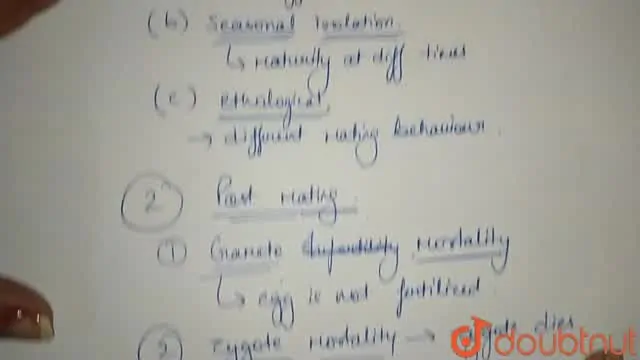Define 'reproduction isolation ' and explain two types of reproductive isolation .
Video Solution
Text Solution
I. Pre-zygotic isolating mechanism : In Pre-zygotic isolating mechanism isolating mechanisms does not allow individuals to mate with each other at all: These are of the fallowing types :
(i) Habitat Isolation : Habitat isolation is the phenomenon in which members of a population living in the same region occupy different habitats. Hence the potential mates do not interbreed among themselves.
(ii) Seasonal isolation: In seasonal isolation, members of a population share the same region but attain sexual maturity at the different times of the year. They thus remain isolated reproductively preventing interbreeding among themselves.
(iii) Ethological isolation : Ethological isolation is seen when members of two populations have different mating behaviours.
(iv) Mechanical isolation: M echanical isolation is seen when the members of two populations have differences in the structure of reproductive organs.
II. Post-zygotic isolating mechanisms: In post-zygotic isolating mechanisms, the two individuals can mate but the result of mating is not favourable. Thus the populations remain isolated without the actual genetic exchange. These mechanisms are divided into the following categories :
(i) Gamete mortality : In gamete mortality there is death of gametes. Sperm transfer may take place but the egg is not fertilized due to gamete mortality.
(ii) Zygote mortality : In zygote mortality, the zygote is formed but it fails to thrive. Though the egg is fertilized the zygote does not survive.
(iii) Hybrid sterility: In this isolation, there is the formation of hybrid as the gametes or zygotes do not die but the hybrid farmed is sterile. Sterile hybrid cannot contribute genetically to further generations.
|
Updated on:21/07/2023
Related Playlists
- BOOK - NAVNEET PUBLICATION - MAHARASHTRA BOARDCHAPTER - SHORT ANSWER QUESTIONS -IIEXERCISE - Ch-11 (Chromosomal Basis of Inheritance)18videos
SHORT ANSWER QUESTIONS -II
- BOOK - NAVNEET PUBLICATION - MAHARASHTRA BOARDCHAPTER - SHORT ANSWER QUESTIONS -IIEXERCISE - Ch-15 (Circulation)4videos
SHORT ANSWER QUESTIONS -II
- BOOK - NAVNEET PUBLICATION - MAHARASHTRA BOARDCHAPTER - SHORT ANSWER QUESTIONS -IIEXERCISE - Ch-9 (Organisms and Environment-I)5videos
SHORT ANSWER QUESTIONS -II
- BOOK - NAVNEET PUBLICATION - MAHARASHTRA BOARDCHAPTER - SHORT ANSWER QUESTIONS -I EXERCISE - Chapter 19 : Organisms and Environment - II7videos
SHORT ANSWER QUESTIONS -I
- BOOK - NAVNEET PUBLICATION - MAHARASHTRA BOARDCHAPTER - SHORT NOTES EXERCISE - Short notes on2videos
SHORT NOTES
Similar Questions
Define 'reproduction isolation ' and explain two types of reproductive isolation .
View SolutionReproductive isolation is
View SolutionReproductive isolation is
View SolutionDefine the reproduction
View SolutionTypes Of Reproduction
View SolutionHow does reproductive isolation arise ?
View SolutionTypes OF Reproduction
View SolutionReproductive isolation results in
View SolutionWhat is evolutionary importance of reproductive isolation?
View SolutionGive the significance of reproductive isolation,
View Solution


